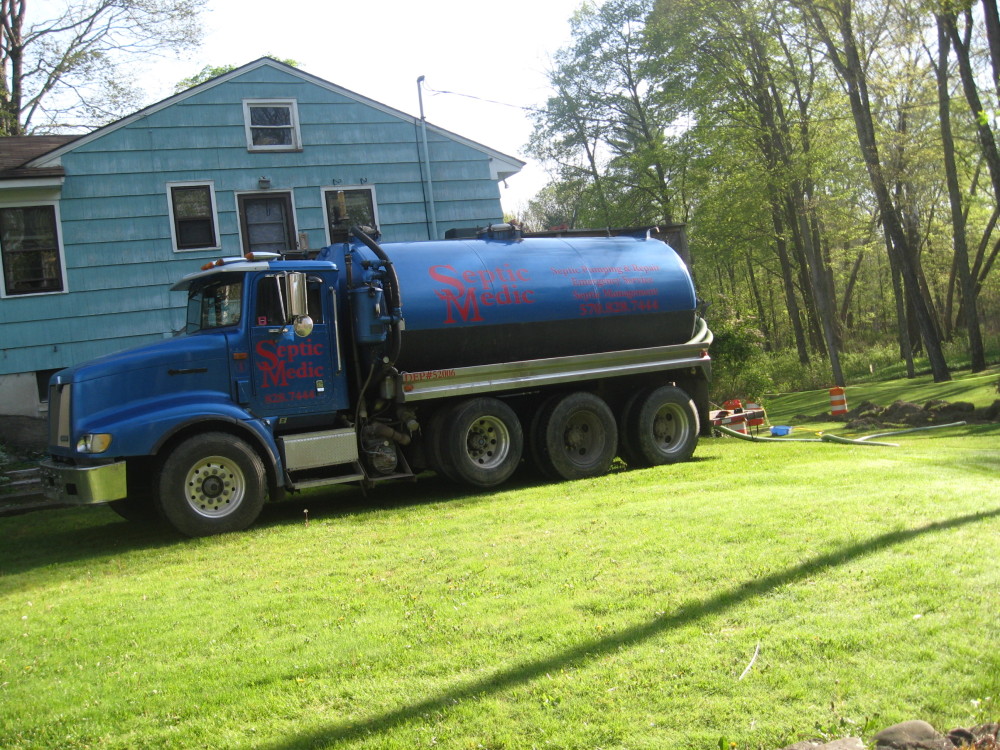
In the Pike County area, including Dingmans Ferry, PA and Bushkill, PA, many homeowners depend on an on-site septic system instead of a standard public sewer system. Located west of the Delaware River and east of the Poconos mountains, Turkey mounds, an elevated sand mound on the property, is the most common form of a septic system in this part of Pennsylvania. Having a relationship with a professional septic system maintenance and repair company and implementing regular maintenance services is the backbone to keeping your septic tank healthy. Without proper maintenance on your septic system you can cause costly damage and reduce the lifespan of your alternative sewage system by years. Investing the time to become aware of the do’s and don’ts about your septic system can provide you with a level of comfort.
Call Septic Medic at 570-828-7444 to learn more about our septic maintenance services for tanks & leach fields
How Much Does Septic Maintenance Cost?
Ultimately the costs of replacing a septic tank far outweigh the costs of yearly or bi-yearly septic system maintenance, and can increase the life and reliability of your system. The cost of a septic system replacement depends on the type of system you have installed on your property and the size of the septic tank that services your home. Price tags ranging from $5,000 to $30,000 are a very good reason to be knowledgable about the benefits of regular septic system maintenance.
How does the Septic System Work?
For those who are completely unfamiliar with septic tanks and septic systems, a septic tank is almost like a living organism; in fact, the bacteria within it is utilized to break down waste products. The septic system is designed to break down solid wastes and directs treated liquids. You have pipes that exit your home (like any other home): pipes running from the shower drain, the toilet, and the sinks. The waste water and solid wastes enters into a septic tank via these pipes. which usually is designed to hold around 1,000 – 1,500 gallons or more.
When new water enters the tank, it pushes out or displaces the older water, which then flows out of the tank into the drain field. Within the drain field or the turkey mound, is where the the old water is slowly absorbed.
Within a healthy septic tank, there are 3 layers:
- The top layer is biomat which breaks down the solids.
- A middle layer of “clear water” that leaves the tank
- A sludge layer at the bottom which is generally solid wastes generated by the bio mat
Turkey Mound vs Conventional Septic Systems
A better understanding of the type of septic system you have and how it works will help you to prevent septic pump problems, prolong the lifespan of your septic equipment, and keep everything working in prime condition.
Mound Septic Systems are typically installed in areas with a high water table or in areas where there is a lack of soil underground. In these instances a pile of sand or gavel, also called a turkey mound, is built above ground to assist with waste water absorption. An electric pump is used to bring the wastewater above ground. Turkey mound septic systems often require more frequent maintenance than a conventional septic system. If suspect that your turkey mound septic system has become clogged with sludge, contact Septic Medic to schedule mound system repairs.
Conventional Septic Systems are most often installed in areas with lower water tables that have enough soil beneath the ground to support wastewater treatment components, including a tank and drain field. Depending on how much clay is contained in the dirt effects the absorption process. Septic maintenance services for a conventional system can occur approximately every three years compared to every one year for a turkey mound system.
What to Expect When You Schedule Septic Maintenance Services?
When we talk about septic maintenance services, the following areas are important to check out:
• Checking sludge levels to ensure they are not getting too high within the tank
• Looking for liquid waste that may be appearing on the surface of the ground
• Ensuring that baffles are intact and functioning properly
• Inspecting the tank lid for cracks
• Pumping your septic tank, which is recommended every 2 to 5 years depending on your usage
• Learning about what you can and cannot flush down the toilet, which can include disposable wipes, certain types of cleaning solutions and much more.
Septic Medic highly recommends that you schedule annual maintenance services in order to keep your septic system healthy. If you have a large family and use your septic system more than the average household, then we suggest getting biannual inspections.
Septic Emergency? Contact us immediately at 570-828-7444
Additional Septic Services include
